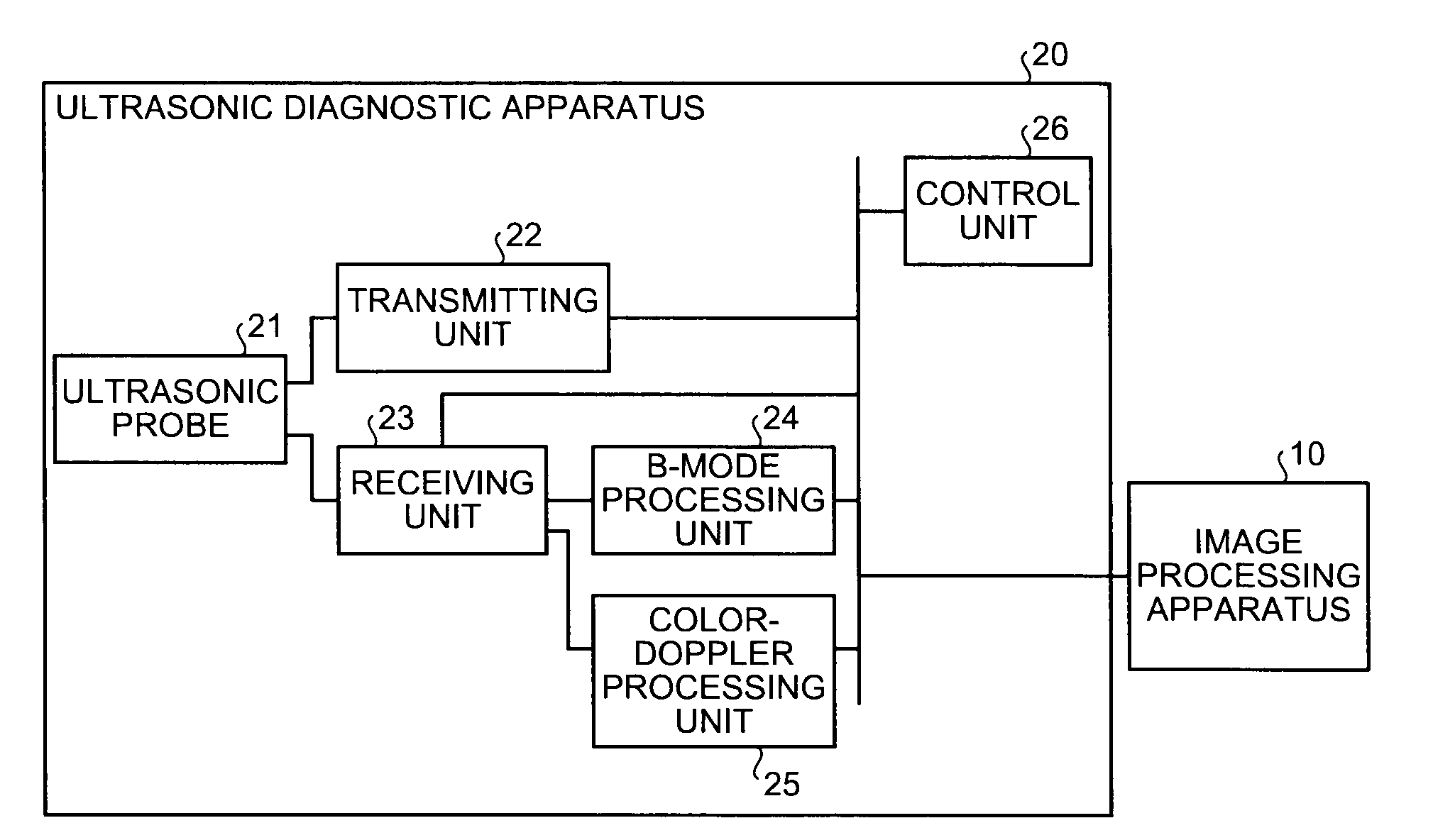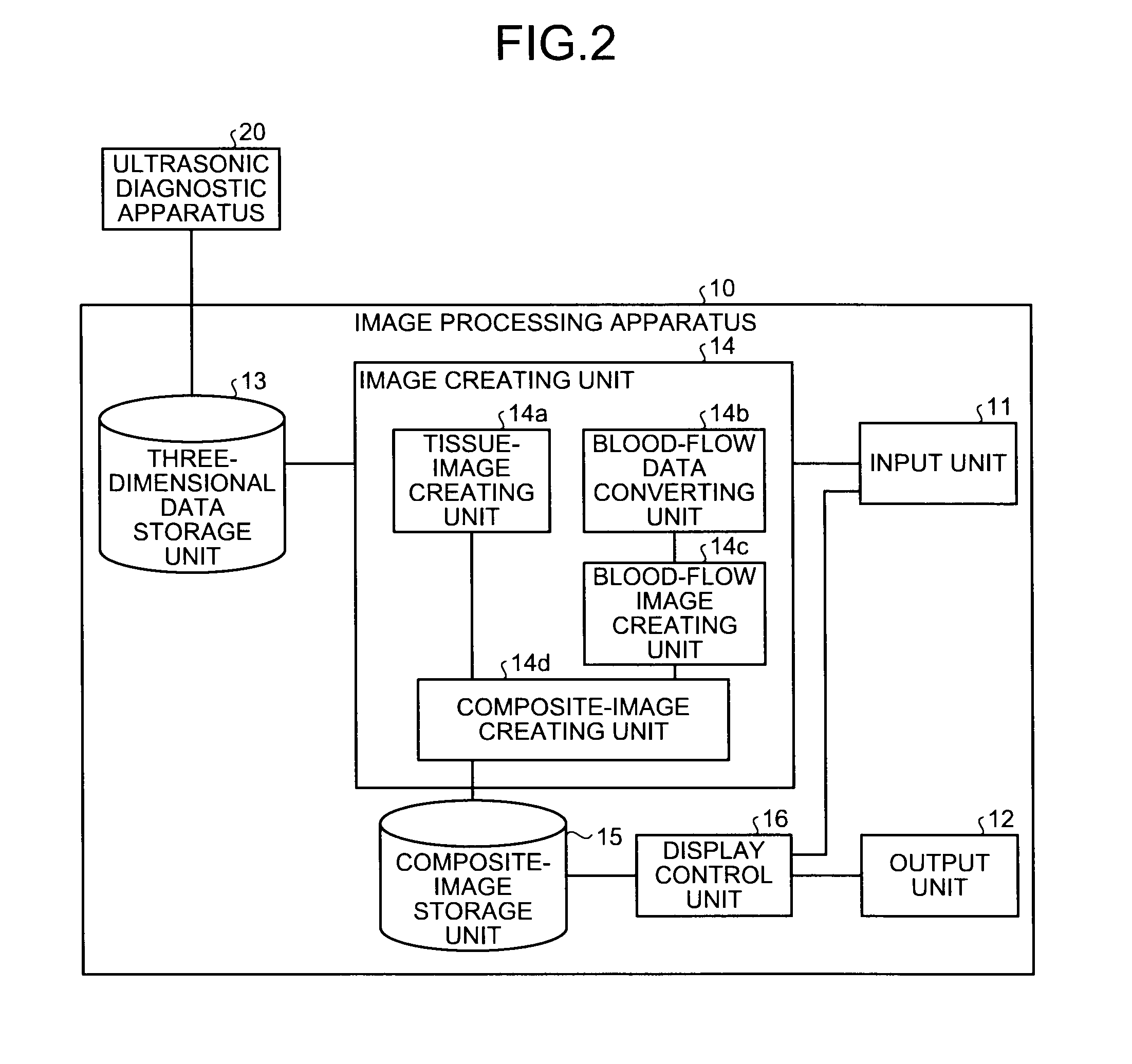Image processing apparatus and computer program product
a technology of image processing and computer program, which is applied in the direction of instruments, tomography, ultrasonic/sonic/infrasonic diagnostics, etc., can solve the problems of three-dimensional information about blood flow three-dimensional information about histology not being displayed in a format suitable for diagnosis,
- Summary
- Abstract
- Description
- Claims
- Application Information
AI Technical Summary
Benefits of technology
Problems solved by technology
Method used
Image
Examples
first embodiment
[0032]As shown in FIG. 1, an ultrasonic diagnostic apparatus 20 to be connected to the image processing apparatus includes an ultrasonic probe 21, a transmitting unit 22, a receiving unit 23, a B-mode processing unit 24, a color-Doppler processing unit 25, and a control unit 26.
[0033]The ultrasonic probe 21 is a two-dimensional array transducer ultrasonic probe that includes built-in ultrasonic transducers arranged in matrix, transmits a ultrasonic wave generated by the ultrasonic transducers into the inside of a subject, and receives a reflected wave from internal tissue of the subject, thereby scanning three-dimensionally the inside of the subject.
[0034]The transmitting unit 22 is connected to the ultrasonic probe 21, generates a high-voltage pulse on each predetermined delay time in accordance with the control of the control unit 26, which will be described later, and applies the generated high-voltage pulse to the ultrasonic transducers built-in the ultrasonic probe 21 in order...
second embodiment
[0107]As described above, a composite image can be created through one time of volume rendering, so that display processing of the composite image can be quickly performed.
[0108]Although the first embodiment is explained above in a case where three-dimensional tissue data is displayed by creating a three-dimensional image by volume rendering, the present invention is not limited to this, and can be applied to a case of creating and displaying a cross-sectional tissue image corresponding to a certain cross section in the three-dimensional tissue data.
[0109]Sometimes histology of a portion other than the heart and an embryo (for example, a tumor portion in the liver) cannot be expressed precisely in three-dimensional structure by volume rendering in some cases. In such case, the use of a Multi Planar Reformat (MPR) image is suitable as an image that depicts histology.
[0110]The tissue-image creating unit 14a creates an MPR image corresponding to a cross section received from the opera...
third embodiment
[0116]Specifically, as shown in FIG. 12, the blood-flow data converting unit 14b determines whether or not to display (display / non-display) three-dimensional blood-flow data (three-dimensional information about a blood flow having depth) on each pixel of a composite image in accordance with random numbers that spatially and temporally vary.
[0117]By determining display / non-display by using random numbers that spatially and temporally vary, the blood-flow data converting unit 14b according to the third embodiment creates three-dimensional particle data converted with scattered particles from the three-dimensional blood-flow data, similarly to the three-dimensional particle data explained in the first and second embodiments. Moreover, by using random numbers that vary not only spatially but also temporally, the blood-flow data converting unit 14b according to the third embodiment creates the three-dimensional particle data that particles shift along time sequence.
[0118]The shape of a ...
PUM
 Login to View More
Login to View More Abstract
Description
Claims
Application Information
 Login to View More
Login to View More - R&D
- Intellectual Property
- Life Sciences
- Materials
- Tech Scout
- Unparalleled Data Quality
- Higher Quality Content
- 60% Fewer Hallucinations
Browse by: Latest US Patents, China's latest patents, Technical Efficacy Thesaurus, Application Domain, Technology Topic, Popular Technical Reports.
© 2025 PatSnap. All rights reserved.Legal|Privacy policy|Modern Slavery Act Transparency Statement|Sitemap|About US| Contact US: help@patsnap.com



